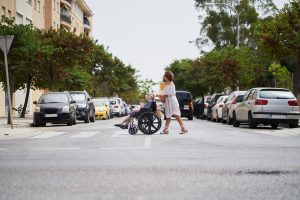
As springtime and warmer weather approaches, we will see an increase in the number of pedestrians celebrating the end of winter in the fresh air and sunshine. Unfortunately, this increase in foot traffic will also mean an increase in pedestrian involved crashes and fatalities; 92% of crashes involving pedestrians result in serious injuries or deaths. In 2021, 130 pedestrians in Maryland died after being struck by a vehicle. Pedestrian safety laws are part of the solution to this problem. However, we must also ensure pedestrians and drivers work together, sharing the road to guarantee safety for all. Here are some important safety tips for drivers and pedestrians:
How Drivers Can Keep Pedestrians Safe
Obey All Traffic Signals
Traffic signals not only direct the flow of vehicles, they help pedestrians anticipate where and when there will be cars moving on the road. Heeding all traffic signals and safety laws ensures everyone’s safety.
Never Drive While Tired or Impaired
Drowsy driving is extremely dangerous because it impacts your attention span, judgment and reaction time. This is similar to the effects of impaired driving, which is not only extremely dangerous to motorists and pedestrians, but also illegal.
Avoid Distractions While Driving
Put away your cellphone, turn down your music and make sure pets are secure while you drive. These distractions could place you and nearby pedestrians in a dangerous situation because you might not see them or changing traffic signals.
Use Your Lights When Visibility is Low
This is not only the law in Maryland, but a best practice as well. Always use your headlights at night, dusk, in bad weather, when windshield wipers are active or in any situation where visibility is low. Not only will this increase your sight range, it will also make your vehicle more visible to pedestrians and other vehicles on the road.
Be Extra Cautious in Areas with More Pedestrians
Areas with a large pedestrian presence are the areas where most pedestrian-involved crashes occur. In areas with pedestrians, slow down and pay attention. Work zones, school zones, commercial districts, and neighborhoods with children require that drivers be extra vigilant.
Make Eye Contact
When you encounter a pedestrian waiting to cross, make eye contact with them or wave to be sure they see you and to let them know you see them. Be courteous and allow them to cross safely.
Dangerous Situation? Use Your Horn!
If you realize a pedestrian is in danger and need to get their attention, use your horn. If they are wearing headphones or otherwise unaware of the potential danger, you may save their life.
Walk Smart – Everyone is a Pedestrian
Even if your primary means of transportation is driving, we are all pedestrians at some point. While driving, treat pedestrians with the same respect and courtesy you would want for yourself. When you’re traveling by foot, walk smart! Look up, look out and always stay alert.
Traveling Safely on Foot
As a pedestrian, even a low-speed crash could send you to the hospital, or worse. Remember these safety tips any time you’re traveling on foot:
Dress for Visibility
Whether it’s day or night, you should dress for visibility. Brightly colored clothing is ideal during daytime. At night, wearing reflective gear will help drivers see you. It is also helpful to use lights in areas where streetlights are minimal or nonexistent.
Plan a Safe Route
Whenever possible, make sure there are sidewalks, crosswalks, and pedestrian crossing signals along your route. If you know there is construction or another issue that could pose a safety hazard, choose an alternate route.
Keep a Safe Distance from the Road
Whether you’re walking or waiting at the curb, always keep a safe distance from where vehicles will be passing by. If there are no sidewalks available, be sure to walk on the left side of the roadway, facing oncoming traffic.
Be Predictable
It’s dangerous to take drivers by surprise. Walk on sidewalks, cross at crosswalks, and use intersections while following all traffic signals.
Avoid Distractions
You need all your senses to be a safe pedestrian. Put your phone away and save your texts and calls for when you get to your destination. Avoid the temptation to wear headphones, but if you must, use them in one ear only. Generally, you can hear a car before you can see it.
Look Both Ways
This is what we teach children, but it’s a good reminder for adults, too. Look left, right, and then left again to make sure no traffic is coming before you enter a roadway. You should continue to look for oncoming vehicles until you have safely crossed.
Make Eye Contact with Drivers
Anytime you cross the road at an intersection where a driver is stopped, make eye contact with the before you step into the road.
Never Leave it All Up to Traffic Signals
It is dangerous to blindly trust traffic signals and assume the walk signal means it’s safe. Once the pedestrian crossing signal is lit, make sure to look for cars before and during your street crossing.
Anticipate and Be Cautious
Practice extra caution in areas where you know cars may be traveling. Be aware of areas where cars might be turning, backing out or entering driveways. When there is bad weather or low visibility, remember it is more difficult for drivers to see you. Pause before crossing in front of or behind vehicles and look for acknowledgement from drivers that they are aware of your presence.